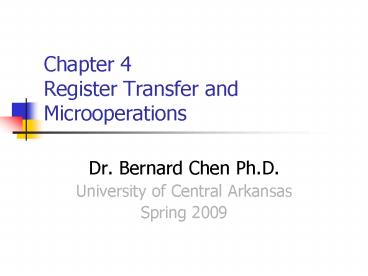Chapter 4 Register Transfer and Microoperations - PowerPoint PPT Presentation
1 / 22
Title:
Chapter 4 Register Transfer and Microoperations
Description:
Register C. Register B. Register A. Used for highest bit from each register. Used for lowest bit ... Tri-State : 0, 1, High-impedance(Open circuit) Buffer ... – PowerPoint PPT presentation
Number of Views:1323
Avg rating:3.0/5.0
Title: Chapter 4 Register Transfer and Microoperations
1
Chapter 4 Register Transfer and Microoperations
- Dr. Bernard Chen Ph.D.
- University of Central Arkansas
- Spring 2009
2
Outline
- Bus Transfer
- Memory Transfer
- Microoperations
3
This Chapter contains
- A basic computer
- 1. The set of registers and their functions
- 2. The sequence of microoperations
- 3. The control that initiates the sequence of
microoperations
4
Register Transfer
- Data can move from register to register.
- Digital logic used to process data
- for example
C ? A B
5
Building a Computer
- Needs
- processing
- storage
- communication
6
Multiplexer-Based Transfer for TWO 4-bit registers
0
1
Use of Multiplexers to Select between Two
Registers
7
Bus Transfer
- For register R0 to R3 in a 4 bit system
4-line common bus
S1 S0
Register D
Register C
Register B
Register A
Used for lowest bit
Used for highest bit from each register
8
Question
- For register R0 to R63 in a 16 bit system
- What is the MUX size we use?
- How many MUX we need?
- How many select bit?
9
Three-State Bus Buffers
- A bus system can be constructed with three-state
gates instead of multiplexers - Tri-State 0, 1, High-impedance(Open circuit)
- Buffer
- A device designed to be inserted between other
devices to match impedance, to prevent mixed
interactions, and to supply additional drive or
relay capability
10
Tri-state buffer gate
- Tri-state buffer gate Fig. 4-4
- When control input 1 The output is
enabled(output Y input A) - When control input 0 The output is
disabled(output Y high-impedance)
Normal input A
If C1, Output Y A If C0, Output
High-impedance
Control input C
11
The construction of a bus system with tri-state
buffer
A0 B0 C0 D0
Select input
Enable input
12
Memory Transfer
- The transfer of information from a memory word to
the outside environment is called a read
operation - The transfer of new information to be stored into
the memory is called a write operation
13
Memory Read and Write
- AR address register
- DR data register
- Read DR ? MAR
- Write MAR ? R1
14
Arithmetic Microoperations
Multiplication and division are not basic
arithmetic operations Multiplication R0
R1 R2 Division R0 R1 / R2
15
Arithmetic Microoperations
- A single circuit does both arithmetic addition
and subtraction depending on control signals. - Arithmetic addition
- R3 ? R1 R2 (Here is not logical OR. It
denotes addition)
16
Arithmetic Microoperations
- Arithmetic subtraction
- R3 ?R1 R2 1
- where R2 is the 1s complement of R2.
- Adding 1 to the ones complement is equivalent to
taking the 2s complement of R2 and adding it to
R1.
17
BINARY ADDER
- Binary adder is constructed with full-adder
circuits connected in cascade.
18
BINARY ADDER-SUBTRACTOR
- The addition and subtraction operations cane be
combined into one common circuit by including an
exclusive-OR gate with each full-adder. - XOR
- M b
- 0 0 0
- 0 1 1
- 1 0 1
- 1 1 0
19
BINARY ADDER-SUBTRACTOR
- M 0 Note that B XOR 0 B. This is exactly
the same as the binary adder with carry in C0
0. - M 1 Note that B XOR 1 B (flip all B bits).
The outputs of the XOR gates are thus the 1s
complement of B. - M 1 also provides a carry in 1. The entire
operation is A B 1.
20
BINARY ADDER-SUBTRACTOR
21
4-bit Binary Incrementer
- Adds one to a number in a register
- Sequential circuit implementation using binary
counter - Combinational circuit implementation using Half
Adder - The least significant HA bit is connected to
logic-1 - The output carry from one HA is connected to the
input of the next-higher-order HA
22
4-bit Binary Incrementer
B3 B2
B1 B0 1
Always added to 1
C4
S3 S2
S1 S0






























